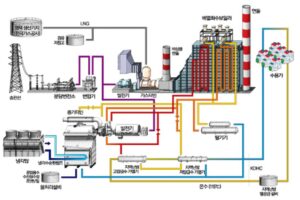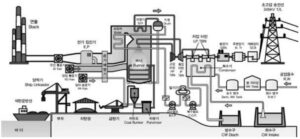▣ Steam Turbine Auxiliary Equipment
1) Condenser
– Consists of two shells, expanding the turbine exhaust steam into a vacuum state through heat exchange with the cooling water on the tube side, maximizing the steam’s thermal drop to improve turbine efficiency and reuse the condensate as feedwater.
– By installing the low-pressure feedwater heaters No. 1 and 2 on each shell neck, efficient use of space and reduction in pressure drop of extraction steam piping is achieved. The turbine exhaust section and condenser are connected by an expansion joint.
2) Condensate Pump
– When the exhaust from the steam turbine condenses in the condenser and collects in the hotwell, the condensate pump transports it through the gland steam condenser and low-pressure feedwater heaters to the deaerator and deaerator storage tank.
– The condensate pumps are vertical and typically operate with two pumps during normal operation.
3) Condenser Vacuum Pump
– Installed to remove air and non-condensable gases that enter the condenser and separate during exhaust condensation, which otherwise would lower the vacuum and adhere to the internal walls, hindering heat conduction.
– The vacuum pumps are of the package type, usually installed as 50% x 3 sets per unit.
4) Condenser Water Box Vacuum Pump
– Installed to remove air generated by changes in the temperature and pressure of the circulating water that enters the water box, which could degrade the condenser performance and impede the formation of a siphon in the circulating water system.
5) Condensate Transfer Pump and Storage Tank
– Since the boiler feedwater is insufficiently recovered from the condenser, makeup water is supplied from the condensate storage tank based on the hotwell water level (the valve opens and supplies water when the hotwell level drops).
– The condensate transfer pump operates to supply demineralized water to the condenser when the initial vacuum is not formed in the condenser and during the initial filling of the equipment cooling water head tank and the deaerator storage tank.

▣ Feedwater System Equipment
The condensate water heated in the low-pressure feedwater heater is heated in the deaerator, where dissolved oxygen is removed and then transferred to the deaerator storage tank. The feedwater is then heated while passing through the high- pressure feedwater heater tube side by the turbine and motor-driven feedwater pumps and supplied to the economizer at the boiler inlet. The turbine-driven main feedwater pump is installed on the operating floor, while the motor-driven feedwater pump is installed on the ground floor. The deaerator is installed on the deaerator floor to provide effective net positive suction head (NPSH) to the feedwater booster pump.
1) Low-Pressure Feedwater Heater
– The condensate from the condenser is supplied as boiler feedwater, and the condensate in the hotwell is heated before being supplied as boiler feedwater to prevent localized thermal stress and for thermal efficiency.
– The feedwater heater operates in a regeneration cycle, with heating steam supplied from the turbine extraction steam.
– Pressurized condensate flows through the heater tube side by the condensate pump, and the extraction steam from the turbine flows on the shell side, heating the feedwater flowing through the tubes.
– The No. 1 and 2 feedwater heaters are installed on the condenser neck.
2) Deaerator
The functions of the deaerator are as follows:
– First, to remove dissolved gases such as oxygen in the feedwater.
– Second, to provide effective net positive suction head to the feedwater pumps to prevent cavitation by being installed at a high elevation.
– Third, to store feedwater to respond to sudden changes in feedwater demand.
– Fourth, to heat the feedwater by direct mixing with steam.
3) Boiler Feedwater Pump
– Comprises a turbine-driven main feedwater pump, a motor-driven booster pump, and a motor- driven startup feedwater pump.
– To prevent cavitation in the feedwater piping, the motor-driven feedwater booster pump is installed on the ground floor.
– The feedwater pump ensures reliable supply of feedwater to the boiler during operation.
– The turbine-driven main feedwater pump is installed on the operating floor, and the motor- riven startup feedwater pump is installed on the ground floor.
4) High-Pressure Feedwater Heater
– The high-pressure feedwater heater is designed as a horizontal U-tube type for high temperature and pressure applications.
– The extraction steam is desuperheated in the desuperheating zone, condensed in the condensing zone, and the condensate is cooled as it passes through the drain cooling zone before being discharged through the drain pipe.

▣ Circulating Water System Equipment
– The circulating water system supplies seawater to the condenser, equipment cooling water heat exchanger, condenser vacuum pump, and condenser water box vacuum pump. It draws water from the deep-sea velocity cap, passing through the common bay to the CWP structure, where the cooled water is concentrated and supplied to the condenser.
– Major equipment includes trash rack & rake, travelling water screen, screen wash pump, circulating water pump, tube cleaning device, debris filter, and chlorine injection equipment.
1) Circulating Water Pump
– The circulating water pump is a vertical, wet- pit type, which intakes and pressurizes seawater to supply it to the condenser and equipment cooling water heat exchanger. The seawater passing through the condenser and heat exchanger is discharged into the discharge channel.
– Four pumps (25% x 4 units) are installed per unit, with motor-operated butterfly valves for automatic opening and closing during pump operation and shutdown. To prevent plant shutdown in case of a pump trip, at least two pumps are always in operation.
2) Jellyfish and Marine Life Processing Equipment
– Installed to minimize the functional decline of the intake facilities due to the increase in jellyfish and marine life populations.
3) Trash Rack & Rake
– Installed to prevent large debris from entering the intake pumps (debris is moved to the trash pit).
4) Travelling Water Screen
– Installed to prevent fine debris from entering the intake pumps (adhered substances are removed by the screen wash pump).
5) Debris Filter
– To remove floating debris and waste materials in the intake channel, two sets of debris filters per condenser cell are installed between the circulating water pump outlet and the condenser water box inlet, removing the debris that passes through the travelling water screen.

▣ Equipment Cooling Water System Equipment
– Comprising two pumps, two heat exchangers, and one head tank per unit, the equipment cooling water system operates as a closed circuit, supplying various equipment via the pumps and heat exchangers, with the cooled water being recirculated back to the pump inlet. Makeup water is supplied from the head tank.
– The seawater system intakes seawater from the debris filter outlet of the circulating water pump downstream, passing it through the tube side of the equipment cooling water heat exchanger to cool the cooling water flowing through the shell side (when the circulating water pump stops, the seawater cooling water pump is started to cool the equipment cooling water).
1) Equipment Cooling Water Pump
– Two pumps are installed per unit, with one pump on standby (in automatic mode).
– One pump operates during normal output operation (the standby pump automatically starts if the outlet pressure drops).
2) Closed Cooling Water Heat Exchanger
– Removes the heat load from the cooling equipment in the system (two units per unit, with one on standby).
3) Closed Cooling Water Head Tank
– Located on the deaerator floor, it supplies and stores makeup water (maintains flow by head pressure when stopped).
▣ Boiler and Auxiliary Equipment
1) Overview
– Boiler water is separated into water and steam by the steam separator. The water is recirculated through the downcomer, and the steam becomes superheated steam as it passes through the superheater.
– The ventilation system intakes air from the atmosphere via two forced draft fans, supplying combustion air to the boiler through the air preheater. The combustion gas passes through the selective catalytic reduction tower (SCR), air preheater, and electrostatic precipitator before being discharged through the stack by two induced draft fans.
2) Other Auxiliary Equipment
– Water Treatment Equipment
After filtration in the pretreatment system, water is demineralized in the pure water production system and stored in the pure water storage tank. It is then supplied as boiler water, for laboratory use, cooling water system, and auxiliary boiler makeup water. The pure water treatment system comprises UF, R/O, and EDI, with the pure water transfer pump transporting it to the condenser.
– Fuel Oil Transfer Equipment
The startup fuel oil used for boiler combustion utilizes the auxiliary boiler’s fuel oil storage tank. The fuel oil stored in the storage tank is supplied to the main boiler combustion burner by the fuel oil transfer pump.
– Air Compressor Equipment
The compressed air system is divided into the instrument air system (IA) and service air system (SA). The IA system supplies dried compressed air through the air receiver and air dryer to pneumatic automatic control devices and various measurement and control equipment.
